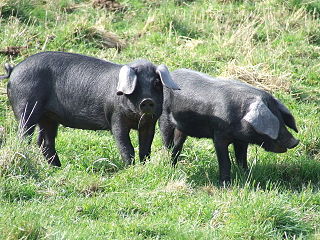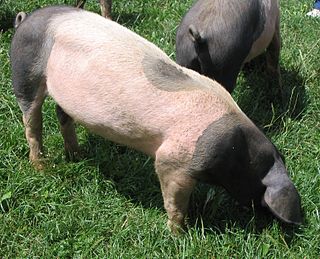Related Research Articles

A pig is any of the animals in the genus Sus, within the even-toed ungulate family Suidae. Pigs include domestic pigs and their ancestor, the common Eurasian wild boar, along with other species. Pigs, like all suids, are native to the Eurasian and African continents, ranging from Europe to the Pacific islands. Suids other than the pig are the babirusa of Indonesia, the pygmy hog of South Asia, the warthog of Africa, and another genus of pigs from Africa. The suids are a sister clade to peccaries.

The wild boar, also known as the "wild swine", "common wild pig", or simply "wild pig", is a suid native to much of Eurasia and North Africa, and has been introduced to the Americas and Oceania. The species is now one of the widest-ranging mammals in the world, as well as the most widespread suiform. It has been assessed as least concern on the IUCN Red List due to its wide range, high numbers, and adaptability to a diversity of habitats. It has become an invasive species in part of its introduced range. Wild boars probably originated in Southeast Asia during the Early Pleistocene and outcompeted other suid species as they spread throughout the Old World.

The guinea pig or domestic guinea pig, also known as the cavy or domestic cavy, is a species of rodent belonging to the genus Cavia in the family Caviidae. Breeders tend to use the word cavy to describe the animal, while in scientific and laboratory contexts, it is far more commonly referred to by the colloquial name guinea pig. Despite their common name, guinea pigs are not native to Guinea, nor are they closely related biologically to pigs, and the origin of the name is still unclear. They originated in the Andes of South America. Studies based on biochemistry and hybridization suggest they are domesticated animals that do not exist naturally in the wild, descendants of a closely related cavy species such as C. tschudii. They were originally domesticated as livestock for a source of meat, and are still consumed in some parts of the world.

Intensive pig farming, also known as pig factory farming is the primary method of pig production, in which grower pigs are housed indoors in group-housing or straw-lined sheds, whilst pregnant sows are housed in gestation crates or pens and give birth in farrowing crates.

Animal husbandry is the branch of agriculture concerned with animals that are raised for meat, fibre, milk, eggs, or other products. It includes day-to-day care, selective breeding and the raising of livestock. Husbandry has a long history, starting with the Neolithic revolution when animals were first domesticated, from around 13,000 BC onwards, antedating farming of the first crops. By the time of early civilisations such as ancient Egypt, cattle, sheep, goats and pigs were being raised on farms.

The domestic pig, often called swine, hog, or simply pig when there is no need to distinguish it from other pigs, is a large, domesticated, even-toed ungulate. It is variously considered a subspecies of the Eurasian boar or a distinct species. The domestic pig's head-plus-body length ranges from 0.9 to 1.8 m, and adult pigs typically weigh between 50 and 350 kg, with well-fed individuals often exceeding this weight range. The size and weight of hogs largely depends on their breed. Compared to other artiodactyls, a pig's head is relatively long, pointed, and free of warts. Most even-toed ungulates are herbivorous, but domestic pigs are omnivores, like their wild relative.

The Gloucestershire Old Spots is an English breed of pig which is predominantly white with black spots. It is named after the county of Gloucestershire. The Gloucestershire Old Spots pig is known for its docility, intelligence, and prolificity. Boars reach a mature weight of 600 lb (272 kg) and sows 500 lb (227 kg). The pigs are white with clearly defined black spots. There must be at least one spot on the body to be accepted in the registry. The breed's maternal skills enable it to raise large litters of piglets on pasture. Its disposition and self‑sufficiency should make it attractive for farmers raising pasture pigs and those who want to add pigs to diversified operations.
Cross-fostering is a technique used in animal husbandry, animal science, genetic and nature versus nurture studies, and conservation, whereby offspring are removed from their biological parents at birth and raised by surrogates. This can also occasionally occur in nature.

The Tamworth, also known as Sandy Back and Tam, is a breed of domestic pig originating in its namesake Tamworth, Staffordshire United Kingdom, with input from Irish pigs. It is among the oldest of pig breeds, but as with many older breeds of livestock, it is not well suited to modern production methods and is listed as "Threatened" in the United States and "Vulnerable" in the UK by the Rare Breeds Survival Trust, as fewer than 300 registered breeding females remain. This animal is of ginger to red colouration and is thought to have descended from wild boars, via native pig stock of Europe. Principal populations today are in the United Kingdom, Australia, the United States, New Zealand, and Canada.

Savaging is a term used in the study of ethology that refers to aggressive behaviour displayed by the mother towards the offspring. Aggressive behaviour includes being rough with, injuring, biting, attacking, crushing and killing of the offspring. While savaging behaviour has been seen in multiple species, it is predominantly demonstrated in domestic pigs. As the definition of savaging is so broad, research on the prevalence of savaging behaviour varies with reports of little savaging of offspring to savaging of offspring up to the 20th percentile. Prevalence of aggressive, non-fatal savaging is greater in gilts as piglet-focused aggression is more frequent in young animals than sows. Occurrence of savaging demonstrated by sows is greater if the sow has previously savaged her offspring either as a gilt or sow. Savaging behaviour usually occurs during the first two days after parturition. Prevalence of savaging is similar among first and second farrowing cycles. Savaging behaviour has a significant impact on both agricultural economy and animal welfare which is why it is currently a subject of interest in the pig industry.

The Javan warty pig, also called Javan pig, is an even-toed ungulate in the family Suidae. It is endemic to the Indonesian islands Java and Bawean, and is considered extinct on Madura. It is listed as Endangered on the IUCN Red List since 1996.

The Large Black pig is a British breed of domestic pig. It is the only British pig that is entirely black. It was created in the last years of the nineteenth century by merging the black pig populations of Devon and Cornwall in the south-west with those of Essex, Suffolk and Kent in the south-east. It is hardy, docile and prolific; it forages well and is suitable for extensive farming, but not well suited to intensive management.

Pig farming or hog farming is the raising and breeding of domestic pigs as livestock, and is a branch of animal husbandry. Pigs are farmed principally for food and skins.

The Red Wattle hog is a breed of domestic pig originating in the United States. It is named for its red color and distinctive wattles or tassels, and is on the threatened list of the American Livestock Breeds Conservancy (ALBC).

Miniature Pigs, also called Mini Pig, Micro Pig, Teacup Pig or Pygmy Pig, are small breeds of domestic pig, such as the Vietnamese Pot-Bellied pig, Göttingen minipig, Juliana pig, Choctaw hog, or Kunekune. Miniature pigs can usually be distinguished from other pigs by their possession of small perked-back ears, a pot belly, a swayed back, a chubby figure, a rounded head, a short snout, short legs, a short neck, and a tail with thick hair at the end. Typically, miniature pigs will range in weight from about 70 pounds (32 kg) to 150 pounds (68 kg).

The Meishan is a breed of domestic pig named for the Meishan, Jiangsu Province, China. It is a sub-group of the Taihu pig and is a small to medium-sized breed with large drooping ears, and wrinkled black skin. Meishan Pigs are extremely docile and renowned for their tender and flavorful red meat pork.

The Swabian-Hall swine is a breed of domestic pig originating from Schwäbisch Hall in Baden-Württemberg, Germany. It is a large pig, white in the centre with a black head and rear and narrow grey bands at the transition from white to black skin. They have large litters averaging more than nine piglets.

The Taihu pig is a domestic breed of pig from the narrow region of mild sub-tropical climate around the Lake Tai region in the lower Yangtze River Valley of China. The breed is a large one, black in colour with a heavily wrinkled face. It has a large head with a broad forehead and large folded ears. The breed has a number of divisions, classified by some authors as strains and by others as separate breeds.
The Beijing Black, also known as the Peking Black, is a breed of domestic pig from China. They are mostly black, but have some white markings. The breed was created in 1962 by cross-breeding a Berkshire with a common Chinese pig. Two other breeds, the Soviet White and the Yorkshire, were also crossbred with native Chinese pigs. It is described as being a "strong, rugged breed" that has "good production traits".
Given the variety of diseases prevalent in swine production, both in the United States and abroad, it is important to understand the risks associated with organic swine production. Overall numbers for certified organic livestock remain low compared to the overall U.S. swine numbers, with approximately 12,000 animals in 2011. However, since 1992, stocks have increased dramatically, with an annual growth rate of 20 percent in total U.S. organic stock. Additionally, there are thousands of non-certified organic swine herds which are not accounted in official statistics, but where farmers still use organic production practices. Consumer demand, stemming from the larger organic agriculture movement has helped spurred growth in this industry. The overall segment, although minuscule compared to the conventional national average, still represents a strong and growing segment in U.S. pork production. The definition of organic swine according to the USDA National Organic Program (NOP), is largely unchanged:
References
- 1 2 Mike R. Taverner, A. C. Dunkin, "Pig production", World Animal Science, vol.10C: Production System Approach, p.337, Elsevier Health Sciences, 1996 ISBN 0-444-88347-9.
- 1 2 "Fengjing" @ Oklahoma State University: Department of Animal Science
- ↑ "Business and Trade Center" Archived 2010-05-28 at the Wayback Machine @ China Fengjing [ permanent dead link ] (Official Fengjing government site).
- ↑ James R. Gillespie, Frank B. Flanders, "Modern Livestock and Poultry Production", pp.396-397, Cengage Learning, 2009 ISBN 1-4283-1808-9.